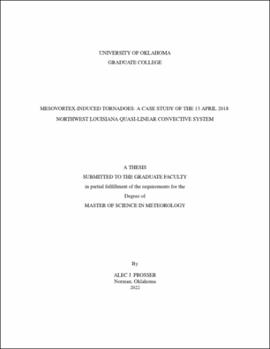| dc.description.abstract | Mesoscale-gamma circulations occurring along the leading edge of Quasi-Linear Convective Systems (QLCS), and their propensity to produce tornadoes and straight-line wind damage has long been noted in literature. Furthermore, this association and the discovery of related features has been reinforced by recent numerical modeling studies of QLCS tornadoes. However, observational data sets of processes sustaining these vortices, genesis mechanisms, specific details of their evolution, and observational confirmation of these modeled features has been elusive.
Just after midnight on 14 April 2018, a tornadic QLCS moved across northwest Louisiana, producing numerous reports of tornadoes. One notable mesovortex-associated tornado caused EF-1 damage along its 22.5 mile path in Shreveport and Bossier City, LA. A second QLCS mesovortex would later produce a brief EF-0 tornado near Sarepta, LA. Both University of Oklahoma C-band, Shared Mobile Atmospheric Research and Teaching Radars (OU SMART-R) were operating in the area at the time the tornadoes occurred as part of the ongoing VORTEX-SE field campaign, allowing for the unique opportunity to investigate QLCS mesovortex intensification and tornadogenesis processes. The resulting datasets from SMART-R1 and SMART-R2 allowed for the construction of an observational domain with dual-Doppler coverage having 2-3 minute temporal resolution.
Analysis of the dual-Doppler dataset allows for a detailed interrogation of vertical structure and mesovortex processes, particularly at low-levels within the storm. Results from these analyses suggest that tornadogenesis occurs in a two-part process. First, momentum surges associated with both the system rear inflow jet (RIJ) and convective downdrafts enhance rear-to-front flow within the developing bow-echo line pattern. Convergence in the region of a developing mesovortex is enhanced by these surges, forcing subsequent low-level updraft formation. This updraft stretches vertical vorticity, increasing rotation considerably. Next, the increasing vorticity at low levels induces an occlusion downdraft, which tilts vortex-region horizontal vorticity into the vertical and allows for further updraft-supported vertical vorticity stretching. These two processes working in conjunction with one another increase the intensity of the mesovortex, eventually leading to tornadogenesis. Mesovortex strength is maintained via a combination of streamwise and crosswise horizontal vorticity tilting within the vortex region. | en_US |
